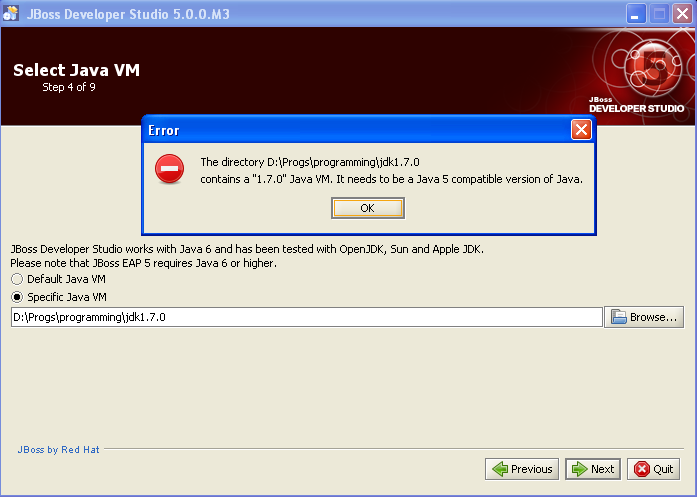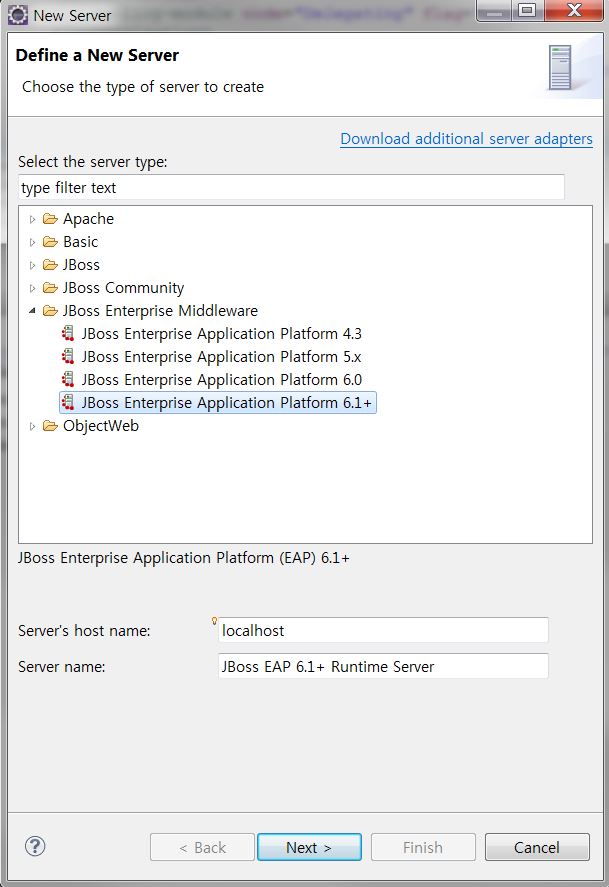Download Jboss Eap 6.1.0 Installer Jar
JBoss Migration Guide CHAPTER 2 Installing and Configuring JBoss This chapter provides instructions for installing and configuring the JBoss Application Server. It includes these topics: • • • • • • • Installing the JDK Before you install the JBoss Application Server, you need to have an up-to-date version of the Java Development Kit (JDK) on your machine. Be sure to install the JDK and not the JRE.
NOTE: You need to have JDK 1.4.2. To install the JDK: • Download the JDK from the to a directory on your machine.• Navigate to the directory and run the Setup program. • Set the JAVA_HOME environment variable to point to the location of the JDK: Platform Instructions Linux Export JAVA_HOME=/usr/java/j2sdk version. To avoid having to set JAVA_HOME each time you open a new shell to start the server, you should add the export statement to the.bashrc file in the user home directory. For example: export JAVA_HOME=/usr/java/j2sdk1.4.2_06 Windows Open Control Panel>System. On the Advanced tab, click Environment Variables. In the System variable section, add a variable called JAVA_HOME and specify the target directory for the JDK as the value.

• Set the PATH environment variable to point to the bin directory of the JDK: Platform Instructions Linux To avoid having to set the PATH each time you open a new shell to start the server, you should add the export statement to the.bashrc file in the user home directory. For example: export PATH=$PATH:$JAVA_HOME/bin Windows Open Control Panel>System. On the Advanced tab, click Environment Variables.
Installing and running JBoss. Installing and running JBoss JBoss, a free J2. 4 certified application server, is the most widely used open. TLDR; yes, you can use without a support subscription, but no, if you just download the latest EAP binary, you're not allowed to use it in production. Q: If EAP 6.1.0.Alpha is the same as community 7.2.0.Final, why is it called Alpha? A: EAP has a much more conservative and rigid release hardening.
In the System variable section, add a variable called PATH and specify the bin directory for the JDK as the value. PATH = C: j2sdk1.4.2_06 bin • Verify that the JDK is working properly and make sure that the java executable is in your path.

To do this, you can execute java -version at a command prompt.
Before installing the server, you need to check your system to make sure you have a suitable Java installation. JBoss 4 requires either a Java 1.4 or Java 5 (sometimes referred to as Java 1. Free Download Mission Impossible 3 Full Movie. 5) JVM (Java Virtual Machine) to run.
Java 5 is only required to use the newer simplified EJB3 technologies. The choice of JVMs is yours otherwise, but we do recommend considering the Java 5 JVM where possible to take advantage of the latest JVM performance improvements and monitoring capabilities. No matter what JVM is chosen, you should generally prefer the latest stable versions and keep an eye on future bug fix releases for issues that might affect your installation. To verify your Java environment execute the java -version command. This will ensure that the java executable is in your path and that you are using the intended Java version.
The following output shows a Java 5 (sometimes called Java 1.5) JVM. If you don't see the appropriate version, check your JVM installation instructions. $ java -version Java(TM) 2 Runtime Environment, Standard Edition (build 1.5.0_02-56) Java HotSpot(TM) Client VM (build 1.5.0_02-36, mixed mode, sharing) JBoss AS is distributed as part of the Red Hat JBoss Media Kit. Recent JBoss releases are also available (both in binary and source form) online from the JBoss AS downloads page,, and as part of the JEMS distribution, available online. JBoss is released in two forms. The first is a ZIP or tgz archive containing a base JBoss installation. We'll talk about the ZIP version, as any system containing a Java installation will have the tools to extract the archive.
The gzipped tar file requires a gnutar-compatible tar program that can handle the long pathnames in the archive. The default tar binaries on Solaris and OS X do not currently support the long pathnames. The standard JBoss 4.0.4 ZIP distribution is named jboss-4.0.4.GA.zip. If service pack releases later become available, they will contain the SP designation, jboss-4.0.4SP1.zip for example. You can use the JDK jar tool (or any other ZIP extraction tool) to extract the archive contents into a directory of your choice. It does not matter where on your system you install JBoss. Note, however, that installing JBoss into a directory that has a name that contains spaces causes problems on some platforms with Sun-based VMs.
The resulting JBoss installation is a raw installation containing the entire set of JBoss AS services in a completely unconfigured state. It is the quickest way to get a runnable JBoss instance, but the latter work to configure the server can be quite intensive. JBoss now provides a GUI installer that can simplify the installation process. In addition to the basic installation, the installer allows you to select the which services are installed, ensuring all service dependencies are met, secure the installation and configure a default datasource.
Using a custom JBoss install created by the installer can greatly simplify the installation and configuration of JBoss. The installer can be run directly from a web browser using Java Web Start or can be downloaded as an executable JAR file. If you choose the Java Web Start option, you only need to click the Run Installer link for the desired JBoss version on the downloads page. The Java Web Start installer is quick and easy. However, options like command-line install will require manually downloading and running the installer executable JAR.
On many operating system, you can run executable JARs by double-clicking them. If your system doesn't support that, you can run the installer directly from the command line: (The remainder of this guide will assume the JEMS 1.2.0 installer, available from ) $ java -jar jems-installer-1.2.0.jar When you launch the installer, you will be given the option to select the installer language as shown in. This screen only selects the language that the installer will display choices in and has no effect on the language used by JBoss or the applications deployed in JBoss.
Table 1.1. The JBoss AS installer configuration sets Name Description Notes all A full J2EE 1.4 server profile with enterprise extensions such as clustering and IIOP. Default A base J2EE 1.4 server profile. Ejb3 An EJB3 profile supporting the full EJB3 specification with Tomcat This requires a Java 5 runtime and is not a J2EE 1.4 compatible configuration. Ejb3-clustered An EJB3 profile supporting the full EJB3 specification with Tomcat and clustering. This requires a Java 5 runtime and is not a J2EE 1.4 compatible configuration. Jms A JMS 1.1 server profile This is not a J2EE 1.4 compatible configuration.
Minimal A minimal JMX microkernel This is not a J2EE 1.4 compatible configuration. Portal A JBoss Portal 2.4 profile This is not a J2EE 1.4 compatible configuration. Tomcat A Servlet 2.4 container profile This is not a J2EE 1.4 compatible configuration. After selecting the configuration set, you have the option to further customize the installation, customizing the set of services installed. Shows the package selection screen. The installer knows the dependencies between services and will not allow you to configure services in an incompatible way.
This is much safer than the trial and error approach of configuring services by hand from a raw ZIP install. When choosing configuration sets, be aware that you can not add packages that are not a part of the selected configuration set. If you wanted a simple web container (the tomcat configuration) that also had JMS support (the jms configuration), it would be necessary to go to a larger configuration, such as the default configuration, and remove the unwanted packages.
There are some combinations of JEMS components that are not supported directly through the installer. Figure 1.6. Name the configuration Almost all applications require a datasource to connect to a back-end database. JBoss provides an embedded Hypersonic database along with a default datasource to connect applications to. Being able to run applications out of the box makes JBoss very developer friendly. All projects will eventually need to move to a more capable database, but most will choose to do so at the very beginning of the project. The datasource configuration screen, shown in, gives you the option to use the default hypersonic datasource to configure a replacement datasource. Figure 1.8. Configure the default datasource Note that when installing a datasource this way, you must place the correct JDBC driver JAR file the lib directory of your server configuration.
The datasource will not be usable until this is done. See for more information about JBoss directory structure, including the lib directory. The next screen allows you to enable applications isolation, completely separating the classloading space of all applications. Application isolation can be helpful in some instances, but it comes with the cost of requiring slow pass-by-value semantics for passing data between applications. In most cases, it is preferable to use loader repositories to control the sharing of classes on an application-by-application basis rather than enabling isolation for the entire server.
Figure 1.9. Configure application isolation When installed from a raw archive, all JBoss services are left in a developer-friendly state requiring no authentication to access most JBoss services, including administrative services. The installer gives you a chance to secure those services on the security screen, shown in. It is recommended that you enable security for all services. You will be required to enter a password for the admin user.
Onone Photo Suite 7 Keygen on this page. We strongly recommend not using the default password, 'admin'.